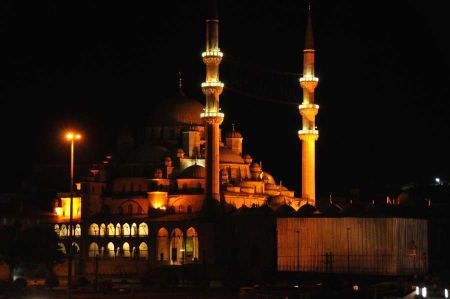Sultan Ahmet Mosque - Blue Mosque in Istanbul
The Sultan Ahmet Mosque or with its more popular name, the Blue Mosque, is located in the oldest part of the city İstanbul, opposite of the famous Cathedral Hagia Sophia, just a short walk from Topkapi Palace.
The Sultan Ahmed Mosque in Istanbul was commissioned by Sultan Ahmed I. from 1609 to 1616, one year before the death of the Sultan, built by a student of Mimar Sinan called Mehmet Ağa. After the secularization, it is today Istanbul's main mosque and a masterpiece of Ottoman architecture, just 500 meters away from Hagia Sophia. In Europe it is known as Blue Mosque because of its wealth of blue-white tiles that decorate the dome and the top of the walls, but are younger than the building itself. Historically significant are the tiles on the lower part of the walls and the stands: they origin from the heyday of İznik pottery and show traditional floral motifs, where greens and blues dominate. The decorative paintings of the interior was changed to pink.
The mosque has six minarets; only the Prophet's Mosque in Medina with 10 and the main mosque in Mecca with 9 minarets have more minarets then the Sultan Ahmed Mosque. According to his personal chronic's the Sultan, in procurement by architect, asks to golden the minarets. Since the expended gold leaves would not stay within budget, Mehmet Ağa "interrogated" and from the Turkish word altın, for "gold", he made the number altı for "six". Thus, these small errors the architect understood and instead of golden minarets built six minarets and, moreover, conventional in stone and not in gold.
Another story about the construction of the Blue Mosque stating that Sultan Ahmed wished golden minarets to cast some shade on the famous Hagia Sophia.
The prayer room is almost square with 53 m length and 51 m width. The main dome has a diameter of 23.5 m and is about 43 m high. It is supported by four pointed arches and four flat spandrels, resting back on four huge, 5 m thick columns. 260 windows illuminate the interior. The stained glass windows are modern replicas of the original glasses from the 17th century.
Mosque and courtyard were surrounded by a wall, of which now only the northern part exists. It separates the mosque from the other buildings of Kulliye, which still exist today. In the adjacent mausoleum, which is open for visitors, important family members of the Sultan rest, like Ahmed I., his wife and three of his sons: Osman II (1618-1622), Murat IV and Prince Beyazıt.
In the upper part of entry on the west side there is a heavy iron chain. This served to the Sultan, who entered the courtyard on horseback, where he had to tend his head if he did not come up against the chain. This served as an symbolic act, that even the Sultan should not be too proud, before he could enter the mosque.
In parts of the site, the mosque was built on top of the former construction of the Byzantine Great Palace.
Please keep in mind, when entering the Blue Mosque, to the dress code. Of course, in the mosque wearing shoes is prohibited.
Coordinates: 41 ° 0 '19 "N, 28 ° 58' 36" E
Please read as well:
Old historic Istanbul - enjoing sunset in Eminönü
Miraculous Architecture - Hagia Sophia
-
 Blue Mosque - Sultan Ahmet Mosque
Blue Mosque - Sultan Ahmet Mosque
Blue Mosque - Sultan Ahmet Mosque
Blue Mosque - Sultan Ahmet Mosque
-
 Blue Mosque - Sultan Ahmet Mosque
Blue Mosque - Sultan Ahmet Mosque
Blue Mosque - Sultan Ahmet Mosque
Blue Mosque - Sultan Ahmet Mosque
-
 Blue Mosque - Sultan Ahmet Mosque
Blue Mosque - Sultan Ahmet Mosque
Blue Mosque - Sultan Ahmet Mosque
Blue Mosque - Sultan Ahmet Mosque
-
 Blue Mosque - Sultan Ahmet Mosque
Blue Mosque - Sultan Ahmet Mosque
Blue Mosque - Sultan Ahmet Mosque
Blue Mosque - Sultan Ahmet Mosque
-
 Blue Mosque - Sultan Ahmet Mosque
Blue Mosque - Sultan Ahmet Mosque
Blue Mosque - Sultan Ahmet Mosque
Blue Mosque - Sultan Ahmet Mosque
-
 Blue Mosque - Sultan Ahmet Mosque
Blue Mosque - Sultan Ahmet Mosque
Blue Mosque - Sultan Ahmet Mosque
Blue Mosque - Sultan Ahmet Mosque
https://www.alaturka.info/en/turkey-country/marmara-region/1690-sultan-ahmet-mosque-istanbul#sigProIde81f25e717

